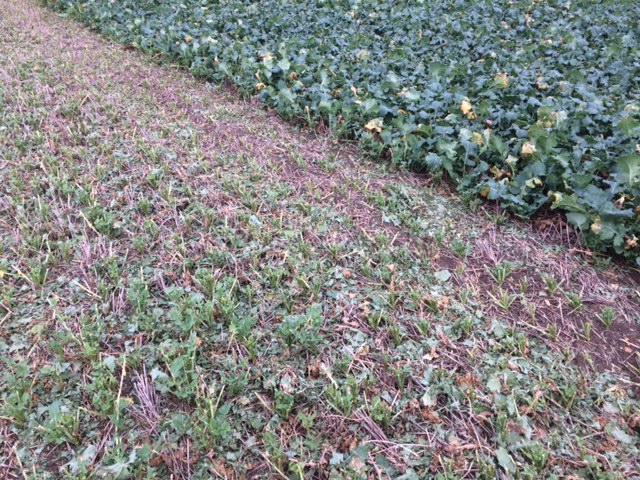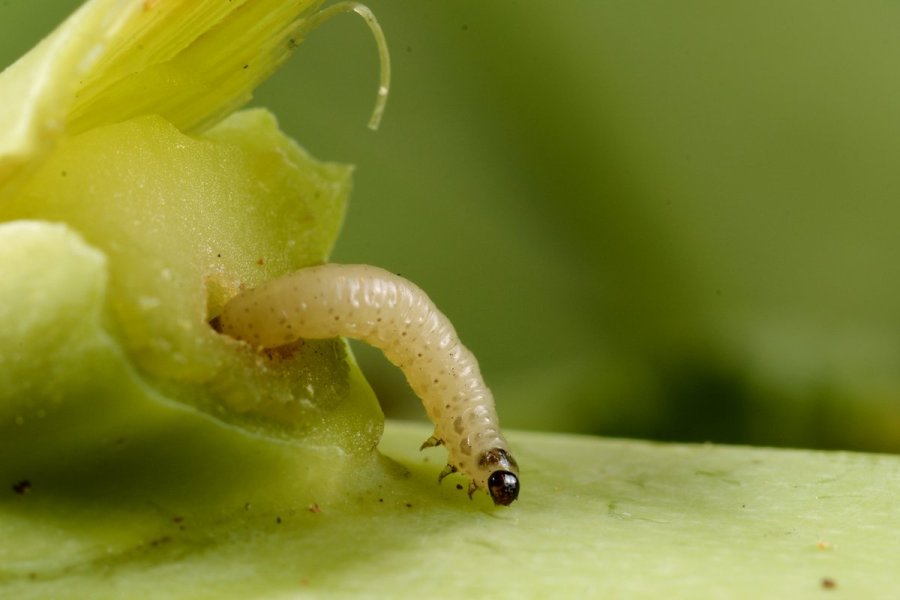With just over half of OSR crops carrying burdens of cabbage stem flea beetle larvae, some may need a helping hand this spring. CPM looks at some of the options.
19 larvae/plant in early Dec is the second highest number ever detected.
By Lucy de la Pasture
Farming without neonicotinoid seed treatments has been a challenge for OSR growers where cabbage stem flea beetle (CSFB) are a problem. Last autumn was no exception, with CSFB activity leading to the AICC predicting a whopping 11% of the crop may be lost to adult and larval damage.
Although OSR is no longer threatened by adult feeding once it starts to grow away, the next stage in their life cycle can be an insidious problem.
Beetles have continued to lay eggs throughout the predominantly kind winter, explains ADAS entomologist Dr Sacha White. “The cold snaps have generally been short, so conditions over the winter have favoured the growth of larvae. At ADAS Boxworth egg numbers were assessed at eight per plant in Dec and this had increased to 19 in Jan, indicating continued egg laying and development,” he explains.
CSFB larvae over-winter in the petioles of leaves, eventually migrating to feed in the stems in the spring. Infestations can severely distort plant growth and, if the growing point is damaged, sometimes kill the plant. Back in the 1980s, researchers looked at the impact of the larvae on yield and found five larvae/plant resulted in a 0.3t/ha reduction in yield (about 10% at that time) and this became the economic spray threshold.
“The data suggested that the higher the number of larvae, the greater the reduction in yield. But the threshold was based on work carried out on old varieties using the agronomic practices of the time.
“More recently we’ve assessed CSFB larvae populations around the country as part of an AHDB-funded project. We found five larvae/plant correlated with 0.5t/ha reduction in yield, though this was survey data and not replicated trials work,” he explains. “Assessing the yield impact of larvae in replicated trials is being done in a current AHDB-funded project – ‘Integrated pest management of CSFB in OSR.”
Monitoring of larval numbers over the winter has shown many crops are carrying a higher than normal load, says Sacha.

OSR crop mown off in Jan on Jonathan Northern’s farm in Lincs as part of the ‘Innovative farmers’ field lab.
“Larvae have become a big problem across the country and it’s one that’s getting worse since the loss of the neonics. One monitoring site recorded 19 larvae/plant in early Dec, which is the second highest number ever detected according to ADAS and Fera survey data.”
Crops harbouring CSFB larvae are often held back in their growth during the winter and early spring. Once the economic threshold is breached, strategies to counter their damage largely hinge around nitrogen management, with pyrethroid sprays an ineffective option due to widespread resistance.
“Struggling crops can really profit from a good early nitrogen boost, and the last thing they need is any check as they come into spring growth,” says Agrii oilseed rape specialist, David Leaper.
Delaying any PGR until green bud or taking advantage of the less stressful growth-regulating effect of extra tebuconazole in the light leaf spot spray might be a better bet, he cautions.
“To prevent light leaf spot taking off, it’s important not to hold back the fungicide to accompany any later-planned PGR. Otherwise, the disease could have devastating consequences for already struggling crops.”
David suggests a similar spring management approach for crops that look reasonable but are likely to be carrying significant burdens of CSFB, which according to AICC survey figures accounts for more than 50% of the national crop this year.
Although CSFB larvae are recognised as reducing OSR yields, crop compensation means the level of loss doesn’t necessarily correlate well to larvae numbers, he adds.
Recent research in badly-infested trials indicates that varieties like DK Exalte and DK Expedient, which grow away earliest in the spring, suffer noticeably less loss of main stems and stunting than later developing hybrids and conventional varieties.
“This makes the type of varieties we’re growing an important consideration here too. Crops with the best ability to compensate need all the help they can get, so don’t write them off because they’re carrying a sizeable larval burden. Withholding inputs is about the worst thing to do and just makes poor performance a self-fulfilling prophecy.
“These crops require greater spring management attention to stimulate canopy development and structuring, as well as the most effective protection against both leaf and stem diseases.”
Matching canopy N applications closely to actual GAIs is crucial in David’s experience. Because the OSR canopy can change so rapidly, he believes N applications are best made based on GAIs measured once growth has started in the spring, rather than too early in the season.
In addition to nitrogen, he stresses that OSR is highly susceptible to shortages of sulphur, magnesium and boron, and moderately susceptible to molybdenum and manganese, making it important to avoid imbalances of these nutrients. Agrii tissue-testing trial work also shows a clear shortfall of potash in higher yield crops from stem extension.
“Actively stimulating the growth of backward crops or those infested with CSFB so they can better withstand the effects of larval damage is also important. Six years of our R&D has shown the ability of the growth stimulant, Nutri-Phite PGA to increase OSR canopy size, greenness and yields. In the absence of an autumn application, we recommend including it with the stem extension spray at 1.0 l/ha.”
For Herts grower, Jonathan Northern, the suggested agronomic measures to help the crop recover from CSFB damage may not be enough. He farms in a hotspot for the pest and has resorted to trying out a radical measure this year to try and reduce the larval load on his OSR crop.
“It’s last chance saloon for our OSR. Adult feeding damage is a problem but over the past few years it’s the larvae that have become the bigger problem and if we can’t control them then we will have to switch to an alternative crop,” he explains.
“Last year it was the early drilled crops that struggled with the numbers of larvae, with later drillings faring much better. This season the exact opposite is true, though we’re finding inconsistent numbers across fields.”
Jonathan has been working with Sacha, hosting trial sites on his farm to investigate alternative methods for CSFB control.
“Sacha was looking for a site where the new crop of OSR was due to be planted adjacent to the OSR crop that had just been harvested. The idea was to allow the volunteer OSR to establish and act as a trap crop, stopping the CSFB from flying into the newly planted crop. And there was certainly a reduction in the incidence of adult damage next to the trap crop,” he comments.
So when Sacha approached Innovative Farmers (a network where groups of farmers can work directly with a researcher to design ‘field labs’ or on farm trials) with an idea to control CSFB larvae, Jonathan was keen to join in.
Research carried out in Canada and Australia showed that where OSR was mown or grazed before the beginning of stem extension to feed livestock, there was no effect on yield. It gave UK researchers the idea that defoliation may be a non-chemical way of reducing larval numbers and trials at ADAS have backed up the thinking.
“I approached Innovative Farmers to help transfer the approach, which has looked promising at reducing the number of larvae in our research trials, to the field,” explains Sacha.
“We used a mower to defoliate trial plots, removing the leaves that provide a winter home for the CSFB larvae within their petioles. Machinery that’s practical on a field scale needs to be trialled on-farm and through Innovative Farmers, we now have a network of between 7-14 growers using a range of different techniques. Some have already defoliated a two header-width strip in their trial field and others are yet to do so,” he comments.
Methods being trialled include using a mower or topper and grazing the crop with sheep over the winter, which could position OSR as dual-purpose crop where there’s livestock, he says.
Jonathan flailed his two OSR trials in Jan with the aim of taking the crop down to 30-40mm from the ground. The sudden loss of the canopy doesn’t concern him because the OSR crop is so resilient and able to compensate, he points out.
“But even with defoliation, we’re not taking all the leaves and larvae out of the crop because we have to be very careful not to damage the growing point,” he comments.
Because the GAI will be much lower on the defoliated crop, it will need more nitrogen, believes Jonathan. “There’s been a lot of work over the past 10 years that correlates the N requirement of the crop with the amount of N within the plant itself, so smaller canopies need more applied N.
“Where we’ve defoliated, we’ve taken all the green matter away and need to recover GAI. Although the debris will decompose and release N back into the soil, it’s not likely to happen in time for the crop in the ground,” he explains.
So he’s taken Sacha’s work a stage further and has a second defoliated strip in the 2ha trial which will receive 40kgN/ha as an early application, in line with N recommendations for a backward crop in the spring.
Sacha plans to monitor larval numbers in the field lab trials during the spring and they will be taken to yield to assess the effectiveness of the treatments. He’ll also be looking at the relationship between topping and the foliar diseases – light leaf spot and phoma stem canker.
“We believe defoliation may be beneficial for reducing phoma infection. The disease starts as leaf lesions in autumn/winter and spreads to infect the stems in the spring. So cutting the stems to remove the leaves and larvae may also have a useful effect on the level of stem canker infection,” he explains.
OSR survey shows jump in flea beetle damage
A 2018 survey of the national oilseed rape area predicts an alarming jump in crop losses attributed to cabbage stem flea beetle attack.
The Association of Independent Crop Consultants (AICC) have conducted the survey since 2016 and in its first year, 77,000ha were surveyed and overall crop losses due to adult damage estimated at 7%, with the hot-spot counties, Beds and Herts, worst affected.
Two years later, assessments carried out by AICC members on a massive 25% (151,000ha) of the 582,000ha national crop show 74% of fields were affected and overall losses at 11%.
The biggest regional increase in pest activity was seen in the South West, highlights Farming Online’s Peter Griffith, who collated and presented the data at the recent AICC Agronomists conference.
Along with the South West (13%), three other regions – Yorkshire (10%), East Midlands (16%) and the South East (12%) – recorded double digit percentage losses.
“There has been an enormous jump in 2018 in all regions except the East, which is thought to be because there is less OSR being grown there,” he explains.
AICC members also conducted mid-Dec larvae assessments this season, with agronomists from four regions providing data on 93 OSR fields.
Jonathan James of southern-based CCC Agronomy points to some regional variation in larvae counts, but overall, a hugely significant 52.9% of total plants assessed had five or more larvae/plant – the economic threshold for spraying.
With the data also showing that earlier insecticide treatments are ineffective in reducing larvae numbers, integrated pest management strategies will be required to tackle the problem, according to his CCC Agronomy colleague Peter Cowlrick.
“Later sowing into Sept to avoid peak adult migration correlated with lower larvae counts in the study and that will impact on variety choice in the future, with more autumn vigour required.”




